Logan Details Growing Suburban Ethnicity to Congress
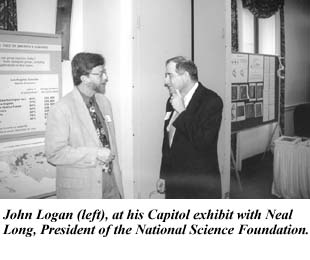 by John LeMay
by John LeMay
Congressional representatives from suburban districts are becoming “quickly aware” that their constituencies are growing more culturally diverse.
That is the observation of John Logan, professor of sociology at the University, who presented a display on “Immigration and the Changing Face of America’s Suburbs” at Washington D.C.’s Capitol in April. Logan represented the American Sociological Association, one of 34 scientific groups assembled at an exhibition sponsored by the Coalition for National Science Funding to promote the National Science Foundation (NSF).
The exhibit took place during Logan’s recent ten-month residency, by invitation, at the Russell Sage Foundation, a research institute in New York City. While there, Logan studied early 20th Century immigration to the New York City area.
Logan’s presentation in Washington grew out of a long-term study, conducted with Albany sociology professor Richard Alba, on “where people live, what jobs they have, and why.” They use data from the 1990 census, mapping techniques, and “walking around neighborhoods,” to investigate the distribution and economic adaptation of recent immigrants. Their project has been funded most recently by a two-year, $174,000 grant from the NSF and HUD.
Alba and Logan found that, beginning around 1970, a clear trend has developed toward Latin American, Afro-Caribbean, and Asian immigrants settling in suburbia, rather than in the cities where previous waves of immigrants have settled. As many as 50 percent of some Asian groups who came to the U.S. in the 1980s were living in the suburbs by the ’90s. The figure is 43 percent for Mexicans, and 37 percent for black West Indians.
This comes at a time when, according to the 1990 census, more residents of the U.S. as a whole live in the suburbs than in cities or rural areas. Many manufacturing and retail jobs have moved there as well, attracting new arrivals.
Logan said the new trend presents a challenge to many legislators, who find they are “no longer representing mainstream white constituents.” He said that representatives and congressional staff members who visited his display showed an interest in the policy implications of his and Alba’s work.
Logan is currently following up on the research he and Alba jointly produced. During his ten-month stay at the Russell Sage Foun-dation in 1995 and 1996, Logan worked on a study of earlier immigrant groups in order to compare them with recent immigrants. Ultimately, the combined study is expected to result in a book that will track immigration to the NYC area from 1920 to the present.
Of his current work, Logan said, “The principle relevance of this look back at earlier white immigration is to dispel some myths about what happened. Did they just waltz in and assimilate immediately? The answer is no.
“There is a strong tendency to romanticize earlier immigrant groups and to accuse current immigrant groups of establishing enclaves and refusing to speak English. But the new groups are in many respects doing the same things in the same time frame as German, Russian and Italian groups did in their time.”
Logan has followed the location and status of ethnic groups in suburbia since early in his career. In 1969 he worked as a community organizer around issues of suburban racial segregation and low-income housing, and he has carried those interests over into his sociological work. Since last spring, Logan has also been a member of the sociology review panel that evaluates grant proposals for the NSF.
Initiatives for Women Hosts 4th Awards
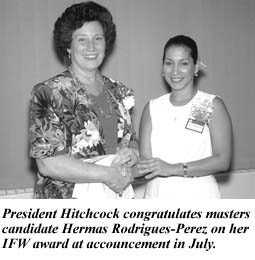 by Lisa James
by Lisa James
A leading official of the Ford Foundation who has published extensively on access for women and minorities into higher education and the impact of women’s studies will be the featured guest when Initiatives For Women (IFW)hosts its Fourth Annual Awards Dinner on Wednesday, Nov. 5 at 5:30 p.m. at Wolfert’s Roost Country Club on Van Rensselaer Boulevard in Albany.
A "Conversation with Alison R. Bernstein” and President Hitchcock will highlight the dinner. Bernstein is the Foundation’s vice president of its education, media arts and culture program. An expert also on community college transfer issues and American Indian affairs, she is the author of American Indians and World War II: Towards a New Era in Indian Affairs.
Tickets for the event are $60, with patron and sponsor tickets, which include a private reception with the keynote speakers, $150 and $100, respectively.
IFW has awarded grants of varying dollar amounts for past four years to assist students, faculty and programs at Albany. Gloria DeSole, senior advisor to the President for affirmative action and employment planning and chair of the Initiatives for Women Steering Committee, said, “The opportunity to make a significant difference in the lives of women whose dreams need support is a privilege.”
Presidential Awards of $1,000 each this year go to:
- Shakira Franco, M.S. student in Epidemiology, to help finish thesis project analyzing prenatal care and assistance programs data to assess racial and ethnic differences of HIV-risk to pregnant women and differences in the proportion of HIV counseling and testing services they receive.
- Hermas Rodriguez-Perez, M.A. student in Latin American & Caribbean studies, to travel to El Salvador to study the reintegration to civilian life of women “guerrillas” after a ten-year civil war.
- Marlene Sarjeant, Ph.D. student in ecology, to hire a student research assistant for her project on the status of the Karner Blue butterfly.
- Mary Sullivan, M.A./C.A.S. student in public history, to replace failed computer equipment.
Other awards, of varying amounts, went to:
- Sherry Baird, of the Academic Affairs staff, to enroll in a GRE course and apply for GRE exam.
- Mary Galvin, part-time faculty member in Women’s studies, for reprint fees to publish her first book.
- Anne Remondi Imhoff, Ph.D. student in counseling psychology, to conduct research on working adults to determine whether the degree of match between interests and occupational type, together with the degree of match between central issues and job issues, predicts levels of job satisfaction overall.
- Institute for Research on Women, a program to promote research and
scholarship on women and gender, publish a newsletter and create a homepage
on the Web.
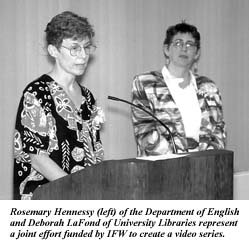
- Deborah LaFond, Donald Juedes, and Rosemary Hennessy, joint effort of University Libraries and departments of English and Women’s Studies, to purchase videos to create a series, “Seeing Women Transnationally.”
- Dawn McCaffrey, a Ph.D. student in sociology, to purchase qualitative data analysis software for her dissertation on understanding the process through which victims of traumatic life events become activists in social movements that address the type of trauma they experienced.
- Jeannine Morell, Office of Human Resources Management staffer, to enroll in an independent study course. Michelle Napierski-Prancl, Ph.D. student in sociology, to purchase computer equipment to assist with her research project on the work experiences of women employed as maids at a residential cleaning service firm.
- Dana Rosenstreich, M.P.P. student in public affairs and policy, to reimburse travel expenses to interview county civil service workers in New York and understand the impact of welfare reform, especially on women clients.
- Sreeroopa Sarkar, Ph.D. student in educational psychology and statistics, to travel to Calcutta, India, to conduct preliminary work identifying social stressors that make young females in that country vulnerable to mental health problems and the coping mechanisms for responding to those stressors.
- Olga Sharoichenko, Ph.D. student, to help pay for international student medical insurance for her and her son.
- Deborah White, Ph.D. student in sociology, to hire a research assistant to code and enter research data concerning women in politics, especially women who ran for Congress.
Special Named Awards:
- Jennine O’Reilly Conway Award ($520): Olga Sharoichenko (for same purpose as above). Fine Art Scholarship Award ($500): Tracy Straight Freed, undergraduate in fine arts, for books and printmaking material.
- Anne Gustin Scholarship for Women in Law and Government ($500): Caron Jacobson, Ph.D. student in criminal justice, for research materials to study rape crisis centers in Eastern Bloc countries.
- University at Albany’s Women’s Association Award ($500 each): Kathy Black, Ph.D. student in social welfare, to complete research on gender differences in communications with hospitalized elderly patients; and Deborah Woeckner-Saavedra, masters student in Latin American & Caribbean studies, to register for additional classes.
- Bernice Mosbey Peebles ‘39 Scholarship Award ($500): Celinda Vanichpong, undergraduate in Spanish, to travel to Spain for Fall 1997 semester.
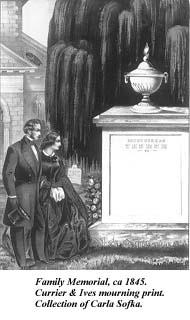
Museum Exhibition Explores Grief, Loss and Survival
The work of art — language, image, form, space, sound, movement — that addresses death may forever evoke the unforgettable lost life and remind us of our own upcoming demise. We are able to metaphorically triumph over death in the both the creation and appreciation of such works. The artist has looked death in the eye, bravely confronted the ghost, and survived with something to show for it.
Harold Lohner
Few human experiences are as powerful and universal and even fewer impact our lives so significantly as those related to death and mourning. Through the use of contemporary art and historical artifacts from differing civilizations, the University Art Museum’s fall exhibition, Memory and Mourning: Shared Cultural Experience, provides opportunities for viewers to explore and expand their understanding of the diverse and common ways in which grief and loss can be expressed and how private and public lives are commemorated.
The first floor Main Gallery features the work of over 20 contemporary
artists. Through a variety of media including painting, sculpture,
photography, and installation, they present visual responses to the concept
of memory and loss.
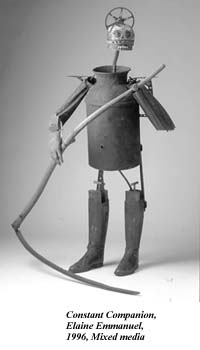
The second floor Mezzanine Gallery includes a variety of collections and artifacts related to the grief process. Historical and cultural approaches to both public and private mourning are addressed through such items as gravestone rubbings, funerary statuary, Victorian mourning memorabilia, and portions of the AIDS quilt. Related prose and poetry texts accompany the displays.
The West Gallery will feature from Oct. 23 - Nov. 9 an installation by Puerto Rican-born artist, Antonio Martorell entitled, Objetos del ausente. It includes a recent series of memento mori drawings by Martorell. The project is a collaboration between Martorell and students from the Department of Latin American & Caribbean Studies.
See dateBook, page 8, for a series of public programs to be done in conjunction with the exhibit. Museum hours are Tuesday - Friday 10-5 p.m., Saturday and Sunday noon - 4 p.m.
Striving Toward Higher Literacy
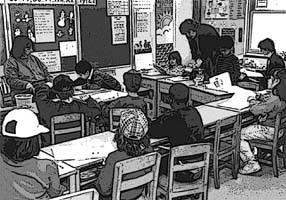 By Christine Hanson McKnight
By Christine Hanson McKnight
English instruction is at a crossroads in America’s classrooms these days, says Judith Langer of the University’s National Research Center on English Learning and Achievement (CELA). That’s because there is no clear consensus about the best ways to teach it, yet it’s so critical to success in the Information Age.
“It is in English classes and language arts classes — reading, writing, listening and speaking — where students are expected to acquire ‘higher literacy,’ those kinds of skills that will enable them to be successful in life. We’re talking about the ability to read well, write well, process information from a variety of sources, and then communicate about what you’ve learned. And yet, there has not been a solid body of knowledge in place about the best ways to teach English and develop the higher literacy skills we need,” says Langer, one of the center’s directors.
To develop a clearer understanding of the best ways to teach English, and in the process improve the nation’s literacy skills, the Center on English Learning and Achievement is carrying out an ambitious, five-year research agenda involving more than 30 scholars from four campuses, as well as teachers and other professionals from about 60 K through 12 classrooms around the nation. When it is completed, the $12.5 million project, funded by the U.S. Department of Education, is expected to have a major impact on the way in which schools and communities approach the teaching and testing of English and the language arts, according to Janet Angelis, associate director of CELA. Researchers will also examine the tradeoffs, including the costs, involved in using different approaches to English achievement.
Leading the effort are Langer and Arthur Applebee, both from Albany’s School of Education, and Martin Nystrand of the University of Wisconsin-Madison, a major institutional partner in the project. All three are nationally known scholars in the field of education. Additional research is being conducted at the Universities of Oklahoma and Washington. Sixteen faculty members from the School of Education are carrying out the research agenda, joined by an equal number of scholars from the other three campuses. Now in its second year, the effort has begun to generate the first of numerous scholarly studies.
No one disputes how vital English classes are in helping students develop the literacy skills they will need for success in other academic subjects and life in general. English is, after all, the course most likely to be required for all students each year they are in school. The issue, says Applebee, “is that we still need more systematic research about the best ways to ensure that all students acquire the literacy skills they need.”
What does it mean to be literate these days? What are the best ways to teach literacy and how do we measure whether those methods are working? What is the nature of the interplay between English and the language arts and the other disciplines?
CELA’s research aims to generate answers to those questions by identifying what elements of teaching and assessment are essential to developing “high” literacy — the literacy necessary to write about, talk about, and extract meaning from knowledge and experience.
“Research on English instruction has lacked a systematic and integrated knowledge base for informed decision making by teachers, administrators, and policy-makers facing increasingly diverse student populations, rapidly changing technologies, higher literacy needs in business and industry and shrinking budgets,” says Langer, whose own research is focusing on a better understanding of “exemplary” instruction” — the best practices, or “best bets” to help students achieve high literacy in middle and high school.
Judy L. Genshaft, Albany’s provost and vice president for academic affairs, pointed out that CELA is one of only 12 nationally funded research centers supported by the Department of Education. “This award reflects the quality of the scholarship within the School of Education and the leadership and stature of Judith Langer and Arthur Applebee,” said Genshaft. “CELA is the one place in the country in which the Department of Education has made a major investment in research into English learning and achievement.” Genshaft said the Center’s research is expected to have a major impact on the nation’s classrooms.
To carry out their studies, CELA’s researchers contacted teachers and other professionals in the field to identify K-12 classrooms with diverse student populations in representative settings across the country. As a result, they are able to look across all of the sites and analyze particular features of instruction, curriculum and assessment that are most effective.
Four separate strands of research are examining integrated language arts instruction in elementary school (grades 1-4), English and cross-disciplinary courses as contexts for high literacy in middle and secondary schools (grades 5-12), the role of technology in the achievement of high literacy, and professional development. Each project within each strand is expected to report annually on its results, and at the end of the five-year period, CELA will provide definitive information about what works for both practitioners and policy-makers.
“Our goal is to be able to offer policy-makers information so they will be able to make choices with some understanding of the implications of their choices,” said Sherry Guice, who is director of educational outreach at CELA and a lecturer in the Department of Reading.
Although organized by strand, most projects also address one or more cross-cutting themes. For example, many projects are examining exemplary classrooms — classrooms in which most students succeed, whether English is their primary or secondary language. Several projects are also investigating various aspects of interdisciplinary or integrated instruction: mathematics and science, English and social studies, English/language arts and other disciplines, and technology and language. Here are highlights of some early findings:
- One of the keys to highly successful first-grade classrooms ise coherence —across subject matter and across time, with teachers constantlye making connections for students, and from one topic or subject to another,stantlye from one day or week or month to the next. The research was carried out by Richard Allington of the Department of Reading and Michael Pressley,t formerly of the Department of Educational Psychology and Statistics.
- Audrey B. Champagne (Chemistry and Educational Theory and Practice) and Vicky Kouba (Educational Theory and Practice) analyzed the literacy and reasoning skills called for in the national science and mathematics standards. They also tested science and mathematics tasks whose successful completion would demonstrate attainment of the standards. Overall, they found a much greater emphasis on reasoning and communication in the, mathematics standards than in the science standards. Champagne and Kouba say their findings raise a number of questions about curriculum, testing and policy. For example, how much time will it take for students to achieve the literacy levels called for in the standards? Should reading and writing about science and mathematics be part of the science and mathematics curriculum? The scholars are now trying to address those questions.
- Several projects are examining interdisciplinary instruction, seeking to determine its use and effectiveness in developing students’ literacy skills. Mary Adler and Sheila Flihan, two graduate students working with Applebee, conducted a literature review on theory, research and practice related to interdisciplinary teaching. In another study, Sandra Mathison of ETAP and graduate assistant Melissa Freeman examined the history of the use of interdisciplinary approaches, including differences across content areas and underlying assumptions about teaching and learning.
- Complementing such baseline studies is classroom research. For instance, Anne McGill-Franzen and Virginia Goatley, both of the Reading Department, are examining actual classroom practice integrating language arts and social studies in elementary classrooms. They have identified issues concerning integration and are now helping teachers shape and refine integrated curriculum. They are examining both the process of integration and its effect on student achievement and learning literacy skills.
- A dozen interrelated studies are expected to shed light on the role of technology in the development of literacy and show how classrooms can use electronic media to acquire literacy. Robert Bangert-Drowns, for example, is working with teachers in several local schools in an effort to understand precisely when the personal computer engages students and makes them active learners. Other faculty members from Educational Theory and Practice who are studying the role of technology in achieving literacy are Joseph Bowman, Carla Meskill and Karen Swan.
- To further understand the complexities of student achievement, CELA researchers are also investigating the preparation and development of teachers. Important, but elusive, aspects of teaching are the adjustments that teachers make not only on a moment-to-moment basis, but also in the longer term as a result of their reflection on their practice. Jane Agee of ETAP is interviewing and observing secondary English teachers to learn more about how they assess themselves and modify their practices to be more effective. One finding: student talk not only influences daily classroom practices, but it also powerfully affects the way teachers try to meet their long-term goals for teaching literature, how they help students learn specific skills, and how they make adjustments to their overall approaches to teaching literature.
Editor’s note: prior to March of 1996, the University at Albany operated the National Research Center on Literature Teaching and Learning, also supported by the U.S. Department of Education. The work of CELA builds on the work of the Literature Center.
